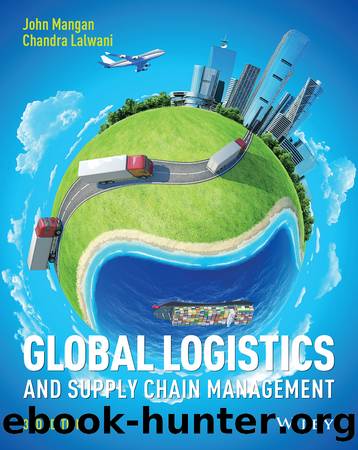Global Logistics and Supply Chain Management by John Mangan & Chandra Lalwani

Author:John Mangan & Chandra Lalwani [Mangan, John & Lalwani, Chandra]
Language: eng
Format: epub
ISBN: 9781119123996
Published: 2016-04-08T00:00:00+00:00
(Note that boxes in Figure 10.4 labelled A, B or C refer to common classifications, where freight classified A is frequently ordered, B less so, and C is rarely ordered.)
Cross-docking bypasses the storage areas in warehouses and distribution centres. Storage should be avoided unless the freight requires one of the four value-adding activities in Figure 10.2, otherwise storage is costly and non-value adding. âCreating bulkâ and âbreaking bulkâ are normally associated with transport economies, while âcombining goodsâ is part of the production postponement principle. âSmoothingâ is associated with holding buffer stock to decouple lean production from the agile supply of goods to the market. As mentioned earlier, this is often at a single inventory holding level and goods are frequently cross-docked rapidly through the supply chain down to this level and then cross-docked again after that level through to the final customer. Cross-docking reduces cost and improves customer service by accelerating the processing of freight requiring reshipment. In bypassing put away, storage, picking and packing, the associated costs and non-value-adding functions are eliminated to enhance customer service. Cross-docking is typically employed for fast-moving freight with constant demand that spends less than 24 hours on site.5 This function is therefore a key enabler of quick response logistics as it will maintain the flow of freight and reduce lead time.
Besides the primary focus on freight flowing down the supply chain, contemporary logistics operations must also manage the reverse movement of freight in the form of defects and customer returns. The impact on warehousing is the requirement for additional processes to inspect, redirect and/or re-store such freight. Furthermore, concerns about the environmental impact of freight are driving legislation such as the European Union's Waste Electrical and Electronic Equipment (WEEE) Directive to require producers to reduce, reuse and recycle. Such developments lead to increased interest in reverse logistics. Clearly, in global supply networks, warehouses and distribution centres play an important role in managing the upstream movement of freight that has reached the end of its usable life. Whilst distribution centres located downstream will store or redirect end-of-life freight, reverse logistics warehouses may employ processes to disassemble freight, and reuse or recycle their components. Chapter 15 will discuss reverse logistics in more detail.
Download
This site does not store any files on its server. We only index and link to content provided by other sites. Please contact the content providers to delete copyright contents if any and email us, we'll remove relevant links or contents immediately.
Time Management Made Easy: How to Cultivate New Habits, Improve Productivity and Get Things Done by Joshua Strachan(2364)
The 7 Habits of Highly Effective People by Stephen R. Covey & Sean Covey(2093)
The Concise Laws of Human Nature by Robert Greene(1712)
Doesn't Hurt to Ask by Trey Gowdy(1555)
Primal Leadership by Daniel Goleman(1123)
Hook Point: How to Stand Out in a 3-Second World by Brendan Kane(1098)
HBR's 10 Must Reads 2021 by unknow(1044)
Don't Sweat the Small Stuff...and It's All Small Stuff by Richard Carlson(1012)
Amazon Unbound by Brad Stone(977)
100 Things Successful People Do by Nigel Cumberland(963)
HBR's 10 Must Reads 2021 by Harvard Business Review(954)
The Job Closer by Steve Dalton(935)
Master of One by Jordan Raynor(933)
Lives of the Stoics by Ryan Holiday & Stephen Hanselman(897)
Declutter Your Mind: A step by step guide to learn to control your thoughts, stop worrying, relieve anxiety and eliminate panic attacks and negative thinking by Mia Chandler(875)
The Power of 100! by Shaun King(841)
Conflicted by Ian Leslie(798)
Coders at Work: Reflections on the craft of programming by Peter Seibel(787)
The Book of Hope by Jane Goodall(743)
